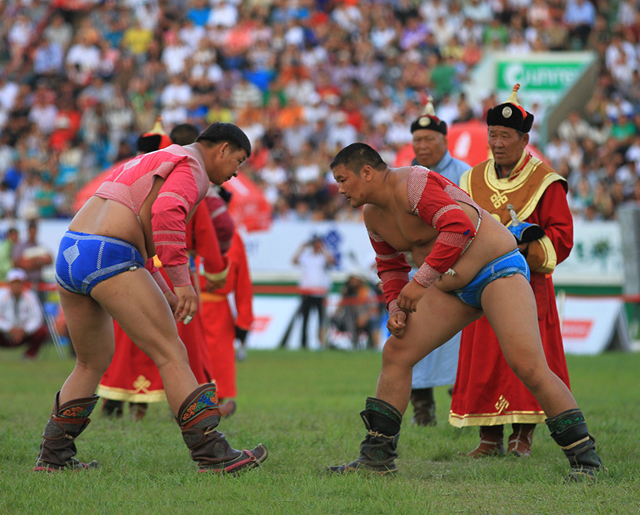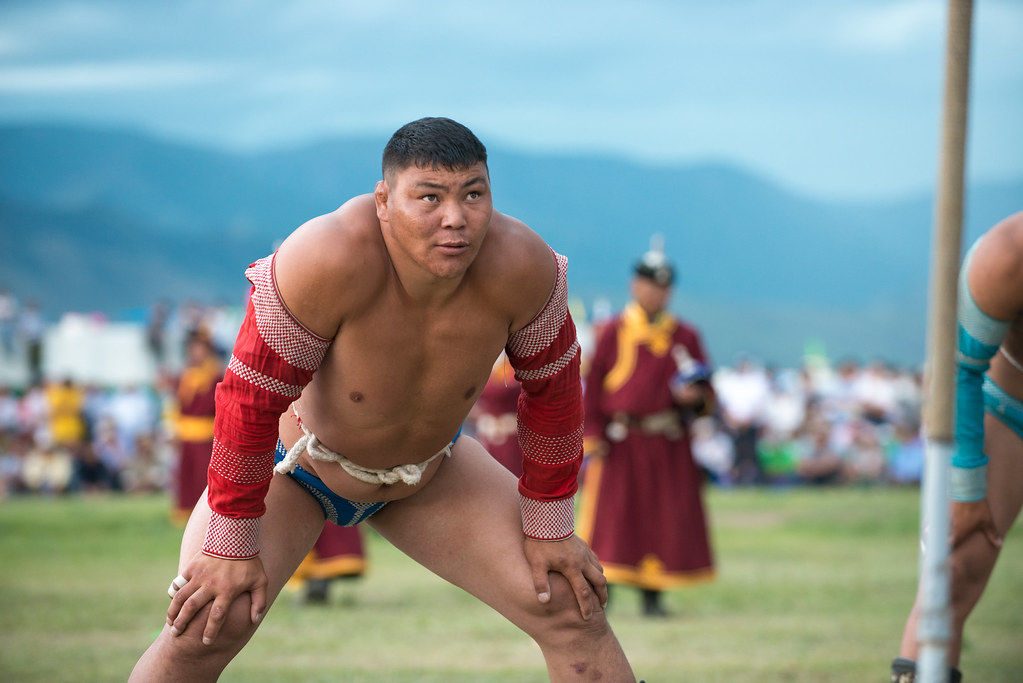If you’ve watched the new Netflix competition Physical: Asia (or seen the highlights making the rounds on social), you might have noticed a thunderous, unmistakable presence: Team Mongolia. They arrived on screen like weather — solid, earthy, and full of muscle memory that traces back centuries. That’s no accident. Mongolia’s national wrestling, Bökh (бөх), isn’t just a sport; it’s a cultural institution, one of the country’s famed “Three Manly Skills” alongside horseback riding and archery. In Physical: Asia, Mongolia’s athletes brought that heritage — and the specific strengths and tactics of Bökh — into a modern, cross-cultural arena of tests, strategy, and spectacle. In this longform piece for Explorer.Company I’ll walk you through Bökh’s history and rules, introduce the Mongolian team on Physical: Asia, and unpack why traditional wrestling skills translate so well (and sometimes awkwardly) to TV fitness competitions.
What is Bökh? A quick primer
Mongolian wrestling — known in Mongolian as bökh — is ancient, visceral, and utterly unlike the structured combat sports people usually think of. It’s said to go back thousands of years and has been woven into the fabric of steppe life since the days of the Mongol Empire, serving historically both as training for warriors and as a communal rite of honor. Wrestlers wear a distinctive outfit (a tight, open-chested jacket called a zodog, short trunks called shuudag, and traditional boots called gutal) and there are celebratory dances and rituals that precede and follow matches. Rank and reputation are built in grand public tournaments like the State Naadam, where hundreds of contestants compete in a single-elimination format, and where physical size is not the only determinant of success — skill, technique, balance, and cunning count for a lot.

A key rule that surprises newcomers: there are no weight classes. Small men and giant men meet on the grass and the winner is the one who keeps his opponent from touching the ground with anything other than his feet. Victory may come by trip, throw, lift, or by unbalancing the opponent enough that they touch a knee, elbow, or back to the earth. Because of those rules, Bökh prizes explosive hip work, base strength, and the ability to manipulate an opponent’s center of gravity — qualities that have obvious carryover into many modern strength competitions. For the most formalized, international expression of those rules you can read the World Nomad Games and official competition guides, which codify how matches are judged, the role of the zasuul (a wrestler’s corner-man), and the ceremonial aspects that make Bökh both sport and theater.

Why Bökh is more than a sport in Mongolia
Wrestling in Mongolia isn’t merely entertainment; it’s a mode of identity. Wrestlers are community celebrities; champions earn special titles (like the heralded “Lion”), and their feats are celebrated at festivals and state events. Because Bökh is traditionally part of Naadam — Mongolia’s massive summer festival that honors the nation’s martial and nomadic roots — the matches are also a kind of cultural mnemonic: they preserve and broadcast values of resilience, honor, and physical competence to every generation. That’s why seeing bikers, bodybuilders, circus performers, and Olympic judokas on Physical: Asia wearing the Mongolian team insignia feels like a continuation of a national story that started on horseback and ends on a modern set lit for global streaming. en.wikipedia.org
Meet Team Mongolia — the people who bring Bökh to Netflix
Physical: Asia assembled national teams from eight countries, and Mongolia’s roster is a carefully chosen hybrid of tradition and modern athleticism. The Mongolian team includes Orkhonbayar “Bökh” Bayarsaikhan — a champion wrestler whose background is steeped in Naadam-level competition — alongside athletes from basketball, MMA, circus arts (handbalancing/contortion), volleyball, and judo. That mix is more than a casting choice: it’s a practical strategy for the show’s varied challenges, which require strength, endurance, agility, and teamwork. The show’s promotional materials and cast list from Netflix and allied press make the lineup clear, and they frame the Mongolian group as a potential dark horse: compact, technically excellent, and used to unconventional matchups (remember, in Bökh a 70 kg man may face a 150 kg opponent).

This team dynamic — the veteran wrestler as anchor paired with explosive, nimble athletes — mirrors how Naadam itself treats wrestling: as a communal game in which technique and mentorship matter. On Physical: Asia, that pays in moments where Mongolian competitors use grip, leverage, and positional control to dominate arena-based tasks that at first glance look more like CrossFit or obstacle-course trials than traditional throws.
Translating Bökh into TV challenges: what carries over, and what doesn’t
Watching a Bökh master step onto a Physical: Asia challenge is fascinating because it reveals how deeply technical traditional wrestling is. Here are a few attributes that carry over well:
- Balance and center-of-gravity control. Bökh teaches you to move your whole body as a unit and to feel when an opponent’s weight is shifting. In balance-based trials, Mongolian athletes often get a tangible edge.
- Explosive hip and leg power. Throws and lifts in Bökh develop fast, brutal strength in relatively short movement ranges — ideal for tasks that require moving heavy objects or flipping a weighted implement quickly.
- Grip and clinch strength. The clinch work that is essential in Bökh shows up in tugging, hauling, and grappling challenges on Physical: Asia.
- Mental toughness and ritual preparation. The ceremonial mindset of Bökh — its pre-match dances, its focus on honor and ritual — helps athletes manage pressure and ritualize performance, which matters under hot lights and high stakes.
That said, there are important limits. Bökh’s rules prohibit certain grabs and focus on throws rather than ground-fighting; it doesn’t have rounds like MMA or technical scoring like Olympic wrestling. So when the show throws a Mongolian wrestler into a timed endurance test or a fine-motor coordination challenge, their advantages narrow. Also, the show’s team-based tasks sometimes require communication strategies and role-sharing that are outside traditional one-on-one Bökh dynamics. In short: Bökh offers powerful physical and psychological tools, but it’s not a turnkey template for winning every modern test — and that tension makes great TV.
Moments on the show that felt like Naadam (and moments that didn’t)
Early episodes of Physical: Asia already give a sense of contrast. There are framed, almost cinematic moments where Mongolian wrestlers perform moves or show an intensity that feels straight out of a steppe festival: big shoulders hunched, explosive hip throws, and that unmistakable dance-step entrance energy. Those scenes land because they reference a living tradition and connect it to athletic excellence that audiences worldwide intuitively understand.
Other scenes show the team learning to parcel resources, to sacrifice a strongman for a strategy, or to navigate interpersonal drama — realities of modern team competition that would be alien to the one-on-one, honor-driven world of Naadam. Both types of moments are useful: one demonstrates cultural durability, the other shows adaptation. The interplay is where the narrative gets interesting.
What Physical: Asia does for Mongolian sport on the global stage
Mass-appeal shows are messy cultural translators: sometimes they flatten nuance, sometimes they magnify pride. In this case, Physical: Asia seems to be doing the latter: it’s broadcasting Mongolian wrestling and athletes to millions who may never have heard of bökh. For tourism, for cultural curiosity, and for young Mongolians who see their sport represented in a modern context, that visibility can be powerful. It’s the difference between a regional festival watched mainly by locals and a global moment where a performance of cultural identity becomes, briefly, world news. Several reliable outlets covering the show emphasize that unique sports — everything from Turkish oil wrestling to Mongolian bökh — are being spotlighted alongside mainstream athletic disciplines, and that casting choices intentionally marry the traditional with the contemporary.
Three practical takeaways for travelers who want to experience Bökh
If reading about bökh and watching Team Mongolia on Netflix makes you itch to see it live, here are quick tips from someone who cares about respectful, meaningful cultural travel:
- Time your trip for Naadam if possible. The national Naadam in mid-July in Ulaanbaatar is the biggest showcase, with hundreds of competitors and formal ranking ceremonies. But regional Naadams (and local tournaments) are held across the countryside and can be wonderfully intimate.
- Learn the etiquette. Don’t touch wrestlers’ ceremonial garments, respect the zasuul’s role, and understand that the wrestlers are performing both sport and ritual. Asking permission to photograph is basic politeness — and often required.
- See beyond the stadium. Bökh is inseparable from nomadic culture. If you can, visit an aimag (province) festival or combine a Naadam viewing with a ger stay so you can ask local hosts about how wrestling fits into seasonal life, livelihoods, and stories.
Final thoughts: continuity, adaptation, and the joy of spectacle
Wrestling in Mongolia is a living bridge between the past and the present. It’s muscle and myth, technique and theater. Physical: Asia did something smart by including a Mongolian team: it acknowledged a tradition that’s physically impressive and culturally rich. The show doesn’t — and can’t — capture everything about Bökh, but it creates hooks. People who watch a Mongolian wrestler produce a textbook hip throw on a neon-lit set might end up on a plane to Ulaanbaatar, circling the Naadam field on a summer morning, and finding in that grass something older and more complicated than a TV highlight reel.
If Explorer.Company readers take one thing away from this piece, let it be this: Bökh is simultaneously a set of movement skills that translate into modern strength sports and a cultural language that tells you who Mongolians are when they gather to celebrate strength, kinship, and history. Seeing it on global platforms like Physical: Asia is an imperfect but valuable moment of exchange — one that can send real curiosity back to the steppe.

